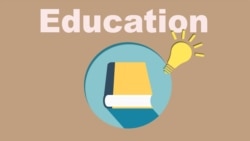Completing a degree program at a college or university can be one of the best things you do to improve your chances of success in life. Higher education is a necessity for many of the best paying jobs in the United States and other countries.
But earning a degree can also be in one of the most difficult things you will ever attempt.
In 2019, a non-profit group noted that 36 million Americans had started on a path towards a degree, but stopped before completing their studies. That number came from the National Student Clearinghouse Research Center.
In 2016, the European Union found that 3 million young people throughout its member nations had suspended their university education.
In 2017, the World Bank reported that across South America, nearly half of all 25 to 29-year-olds had stopped attending higher education without earning a degree. And, South African officials have reported similar levels in their country.
Nichole Torpey-Saboe says there are many reasons why people leave U.S. higher education without earning a degree. And the difficulty of college degree programs is not the top reason people give for leaving, she adds.
Torpey-Saboe is director of research for the Strada Education Network. In December, her group, working with the research company Gallup, released a report on why over 42,000 Americans left school without a degree.
Researchers found the most common reason people gave for leaving was the difficulty of balancing work with their college or university studies. Other reasons were the high cost of higher education and the fact that many students failed to see how their studies related to a career, Torpey-Saboe says.
As for why so few consider returning to complete their education, she told VOA many Americans feel there is little chance of them succeeding if they do.
“They are afraid that they’ve been away from the classroom too long or they’re just worried that the same situations that caused them to drop out before might still be there and make it difficult to be successful if they try again,” she said.
Torpey-Saboe suggests the problem in the United States is not just that these individuals have less of a chance of finding good-paying jobs. These men and women still have to repay loans they took out to pay for their education. And since they will likely have less access to better positions, they will struggle to repay that debt.
This makes an already difficult situation for people who are poor or come from an underrepresented group in higher education that much harder, notes Justin Ortagus.
Ortagus is an assistant professor of higher education policy at the University of Florida in Gainesville. He believes that students like these are often the most likely to drop out.
“If you’re a low income, first generation student, you don’t necessarily have a parent to say, ‘This is what you need to do to enroll’ … or ‘These are the types of courses you need to take to ensure you’re up to date in your individual major.’ You kind of have to learn on the fly and really rely on under-resourced institutions to provide the support and services that you need,” he said.
Yet Ortagus thinks there is hope. Last month he and two other University of Florida researchers released a study on efforts to re-admit students at two-year community colleges across the state.
Community colleges largely serve poor and minority students, many who are working in full-time positions and supporting families. Federal studies show that only about 30 percent of individuals who start their education at such schools earn a degree.
However, the study showed that community colleges were able to help students return in two ways. First, the schools started sending text messages to over 27,000 former students on their mobile phones. The messages provided links so they could immediately enroll in classes or get advice about the next best steps in their education.
The community colleges also offered to pay students for their first class once they decided to return to school. The text messages alone had little effect. But the two efforts together made the individuals in the study 21 percent more likely to re-enroll.
Ortagus argues that this demonstrates how a little financial aid, in this case about $300, can do a lot for those in need. And eventually the cost to the school is covered when the students are in a better position to pay for the rest of their education.
Nichole Torpey-Saboe says these efforts are a good start. But she argues there are still greater changes that need to be made to the entire structure of U.S. higher education.
Torpey-Saboe says one can see evidence of this in the growing popularity of internet-based degree programs. She thinks colleges and universities need to consider offering more classes outside of normal business hours. And, she says lawmakers need to consider giving more money to schools that serve needy students so they can improve their guidance services.
I’m Dorothy Gundy.
And I’m Pete Musto.
Pete Musto reported this story for VOA Learning English. George Grow was the editor. Write to us in the Comments Section or on our Facebook page.
__________________________________________________
Words in This Story
degree – n. an official document and title that is given to someone who has successfully completed a series of classes at a college or university
drop out – p.v. to stop attending a school or university before you have completed your studies
access – n. a way of being able to use or get something
enroll – v. to enter someone as a member of or participant in something
course(s) – n. a group of classes that lead to a degree
major – n. the main subject studied by a college or university student
on the fly – n. quickly and often without preparation
rely on – p.v. to need someone or something for support or help
institution(s) – n. an established organization
mobile – adj. able to move from one place to another












